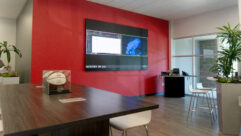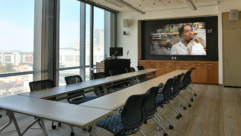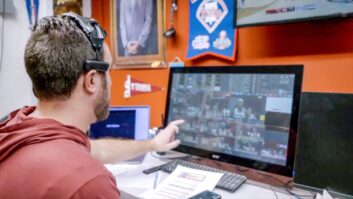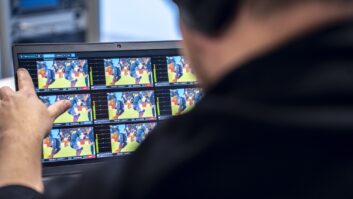
Sharp NoteVision XG-MB70X
Jan 1, 2005 12:00 PM,
By Jeff Sauer
Bright and powerful portable projector.
When the projector industry talks about crossover products, it’s usually referring to projectors that, because of their size and cost, can (at least marginally) serve both as business presentation and home-theater displays. Yet, as manufacturers muscle more lumens and features into ever-smaller frames, old notions about portable projectors and fixed-installation projectors for conference rooms have changed, too.
Sharp NoteVision XG-MB70X
Thanks to those continually increasing brightness numbers, most of today’s business projectors, including those that are permanently installed in conference rooms and boardrooms, are small enough to be moved handily between meeting rooms and classrooms as well. And features typical of fixed-installation models are creeping into very portable projectors.
PORTABLE POWER
Sharp’s new NoteVision XG-MB70X ($4,995 MSRP) is a good example. At 9.1lbs., it has one of the highest brightness specifications (3000 lumens) in a sub-10lb. projector. It also combines remote administration LAN connectivity that one might expect to find in larger business products with portable-oriented features like auto-focus and automatic keystone correction. The result is a projector that feels as comfortable moving around a university or corporate campus as it does staying put in an ivory tower.
This latest NoteVision model features an updated — aerodynamic, if you will — curved-front design with a powered 1.5X zoom/focus lens that juts out from the left side of the projector’s face. There are dedicated control buttons on top for zoom, focus, auto-focus, auto-synch, volume, and keystone, as well as the obligatory navigation arrows. Oddly, the buttons are laid out in something of a compass pattern, but with the navigation arrows on the inside with the other functions positioned farther out toward what would be north, south, east, and west. It’s a bit counterintuitive, and I ended up hitting the keystone and zoom buttons instead of the left and right arrows several times. The buttons are all nicely labeled, just not positioned as I might expect. Sharp does supply a handy Quick Setup sticker to affix to the top of the chassis.
For the most part the MB70X has nothing but standard, basic connectivity options, especially compared to potential “fixed” units. There are two 15-pin RGB ports, one of which can accept a YPbPr component or HD video signal with an optional splitter cable. There’s an RGB monitor pass-through output. S-Video and composite are there, too, as are USB and serial RS-232 for remote mouse functionality, but no DVI. There are two audio-only inputs — one for the 15-pins and one for the S-Video/composite — and one output. All are via stereo mini-jacks.
The most interesting connector, though, is the RJ-45 LAN port on the back panel. There’s nothing particularly revolutionary about it or its functionality, just the fact that it exists on a 9lb., sub-$5,000 projector. As several other manufacturers have already done with their projectors, Sharp now supports direct remote administration of the MB70X, including statistical monitor, remote power up/down, and email notification of trouble. There is no display/picture information sent over Ethernet to this projector (as is the case with a small minority of Ethernet-endowed models), but when the LAN port is “enabled” it allows the unit to be addressed even when in a powered-down state.
Sharp has actually supported IP control and administration in other models, but usually through an optional serial-to-Cat-5 converter module. Building it into the MB70X and including the Display Manager software confirms Sharp’s commitment to IP, which the company has been promoting at trade shows for several months. Interestingly, Sharp’s IP default is to an established address rather than to DHCP automatic addressing, which would allow users to plug it into a network and get going more easily. On the other hand, giving the unit a default, or manually configurable, IP address allows a LAN sys admin to administer to the unit more easily if it were to change locations frequently.
SHINING THE LIGHT
I can find one other sub-10lb. projector on the market with a 3000-plus lumen specification, but Sharp’s 3000 lumen mark is certainly among the best out there in the weight class — and the highest at the price. My own measurements yielded a brightness mark of just 2535 lumens, but regrettably, that type of disparity has become all too common in the industry and is not unexpected. A low-lamp Eco-mode reduces brightness output 15 to 20 percent. Sharp’s economy mode spec is 2600 lumens, but I measured 2178 ANSI lumens. Not surprisingly given those high brightness numbers, I measured a brightness uniformity of 82 percent, and that’s acceptable, even typical, but not very exciting.
The DLP projector’s high brightness is a function of a 275W DC lamp and an adjustable Iris in High Brightness mode. Together, they yield peak lumens, but at the expense of the contrast rating. I measured contrast against the ANSI checkerboard at 233:1 and a full on/off contrast of 1247:1, but that doesn’t tell the story. Just about the entire bottom half of the grayscale range is severely concatenated. Significantly discernable grayscale steps appear only at about 50 percent brightness and higher. Naturally, that really limits the visual sense of color range as well, leaving darker colors often quite indistinguishable from one another.
Of course, you can turn off High Brightness Iris and pick up more grayscale and color, but that is really not the primary target use for the MB70X. It has a four-segment color wheel that’s clearly designed for the highest-lumen output rather than accurate video and color reproduction. That’s not to say that primary and secondary colors are off, just that their luminance range is limited.
Still, for business presentations and spreadsheets, the extra brightness is not a bad trade for a little less subtlety in color. This NoteVision is more about utility than glamour, and that’s augmented by LAN connectivity for remote administration and remote assistance of users in conference or classrooms on the other side of a building or campus. Throw in easy setup features — like auto-focus and automatic keystone correction — that allow a lecturer or presenter to freely reposition the unit without the administrator needing to come to the room, and the MB70X works as well as a portable as it does a fixed projector.
Is that crossover appeal? This projector probably isn’t so much for watching movies at home, but that just reinforces the projector’s very basic appeal for the security-conscious corporate and educational worlds as a hard-working business projector.
PRODUCT SUMMARY
Company: Sharp; www.sharpusa.com
Pros: High brightness for the price; built-in IP-based control.
Cons: Bottom half of the grayscale range is significantly concatenated.
Applications: Data and video projection in educational and corporate meeting rooms.
Price: $4,995
SPECIFICATIONS
Brightness 3000 ANSI lumens (2600 lumens in Eco-mode)
Contrast 2000:1 full on/off
Native resolution XGA (1024×768)
Configuration 1 × 0.7in. DDR DLP 12-degree DMD
Light source 275W DC (rated at 2000 hours, 3000 in economy mode)
Lens F=2.0-2.5, f=21.3-31.6mm; 1.5× power zoom/focus
Keystone ±35 degrees vertical
Speakers 2W mono
Dimensions (WxHxD) 12.2″×3.5″×1.3″
Weight 9.1lbs.
Optional Component Video cable
Warranty Three years parts and labor (90 days/500 hours lamp), plus two-year Sharp “ER” 24-hour Express Repair/Replacement option









